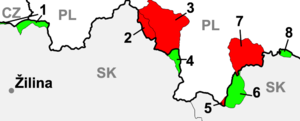| Revision as of 23:59, 28 June 2007 editBrianski (talk | contribs)3,415 editsm →Aftermath: grammar← Previous edit | Revision as of 00:02, 9 July 2007 edit undoHaukurth (talk | contribs)Autopatrolled, Administrators26,987 editsm →Order of battleNext edit → | ||
| Line 17: | Line 17: | ||
| * A motorized unit "]" was created on September 5 but the campaign ended before it arrived on the front. | * A motorized unit "]" was created on September 5 but the campaign ended before it arrived on the front. | ||
| The group was part of the German Army Group South and was subordinated to the 14th Army led by ] (five |
The group was part of the German Army Group South and was subordinated to the 14th Army led by ] (five infantry, three mountain, two tank and one air force division). Bernolák's task was to prevent Polish incursion to Slovakia and to support German troops. | ||
| Their oposition was Polish ] (] Army) consisting of infantry units with some light artilery and no tanks. | Their oposition was Polish ] (] Army) consisting of infantry units with some light artilery and no tanks. | ||
| ==The Campaign== | ==The Campaign== | ||
| The attack started on ], ] at 05:00. | The attack started on ], ] at 05:00. | ||
Revision as of 00:02, 9 July 2007

During the invasion of Poland in 1939 by Nazi Germany the recently created Slovak State joined the attack. Slovak field army had over 50,000 soldiers in three divisions. It met only weak resistance and suffered minimal losses.
Slovak State was created as a client state of Germany on March 14, 1939 on area of Slovakia (whose large part was occupied by Hungary, much smaller areas by Germany and Poland).
Political pretext for the participation in the Polish Campaign was occupation of small part of Slovakia proper by Poland on December 1, 1938, in the aftermath of Munich Agreement (totally 226 km² with 4,280 inhabitants, almost all ethnic Slovaks) and suggestions of some Polish politicians toward Hungary to occupy the whole Slovakia.
During secret discussions on July 20-21, 1936 Slovakian government agreed to participate in the attack and to use its territory as the staging area for German troops. On August 26 the state mobilized (160,000 reservists called, 115,000 entering the service until September 20) its armed forces and created a new field army codenamed "Bernolák" with 51,306 soldiers.
Order of battle
Main article: Field Army BernolákThe army group Bernolák was led by minister of defense Ferdinand Čatloš, had its headquarters in Spišská Nová Ves, since September 8 in Solivar near Prešov and consisted of:
- 1st infantry division "Jánošík" led by Antonín Pulanich in sector Spišská Nová Ves - Prešov.
- 2nd infantry division "Škultéty" led by Alexandr Čunderlík in sector Brezno – Poprad.
- 3rd infantry division "Rázus" led by Augustin Malár in sector east of High Tatra.
- A motorized unit "Kalinčiak" was created on September 5 but the campaign ended before it arrived on the front.
The group was part of the German Army Group South and was subordinated to the 14th Army led by Wilhelm List (five infantry, three mountain, two tank and one air force division). Bernolák's task was to prevent Polish incursion to Slovakia and to support German troops.
Their oposition was Polish Karpaty Army (Carpathian Army) consisting of infantry units with some light artilery and no tanks.
The Campaign
The attack started on September 1, 1939 at 05:00.
The 1st division occupied the village Javorina, town Zakopane and continued toward Nowy Targ protecting the German 2nd mountain division from the left. During September 4-5 it engaged in fight with regular Polish army units. On September 7 the division stopped, 30 km inside Polish territory. Later, the division was pulled back with one battalion remaining until September 29 as the guard in Zakopane, Jurgów and Javorina.
The 2nd division was kept in reserve and participated only in mopping up operations. In this it was supported by the Kalinčiak group.
The 3rd division had to protect 170 km of border, from Stará Ľubovňa to the border with Hungary. It fought minor skirmishes and after several days moved into the Polish territory, stopping on September 11.
Three Slovak air squadrons (the group was codenamed "Ľalia", Lily) were used for reconnaisance, bombing and as the close support for German fighters. Two planes were lost (one to the anti-aircraft fire, one crashed), one enemy plane was shot down.
Total infantry losses were 18 dead, 46 wounded and 11 missing.
Aftermath

All Slovak units were pulled back until the end of September 1939. On October 5 a victorious military parade was hold in Poprad. The mobilized units were gradually demobilized and the Army Group Bernolák was disbanded on October 7.
Slovak Army took around 1,350 prisoners. In February 1940 around 1,200 were handed to Germans, some to the Soviets and the rest was kept in Slovak prison camp in Lešť.
All the disputed territory, whether anexed by Poland in 1920 or in 1938 was given to Slovakia (this was confirmed by the Slovak parliament resolution on December 22). Hitler's offer to annex Zakopane was rejected. This arrangement lasted until July 1945 when the border line was returned to the state from year 1920.
The Slovak Army obtained some prestige lost during the Slovak-Hungarian War. In 1941 Slovakia joined the attack on the Soviet Union from its start.
Literature
- Charles K. Kliment and Břetislav Nakládal: Germany's First Ally, Schiffer Publishing, 1998, ISBN 07-643-0589-1. The book covers the Slovak Armed Forces in World War Two. Czech edition in 2003, ISBN 80-206-0596-7.
- Igor Baka: Slovensko vo vojne proti Poľsku v roku 1939 (Slovakia during the war against Poland in 1939), Vojenská história, 2005, No 3.
External links
- Overview of the campaign (in Czech)
- Another overview, more military details (in Czech)
- Changes in Polish-Slovak border between 1920-1945 (in Slovak)